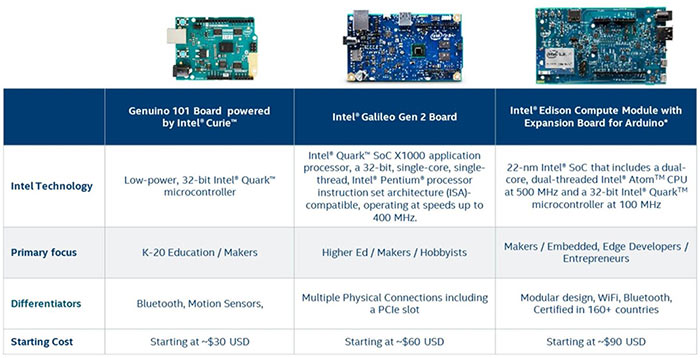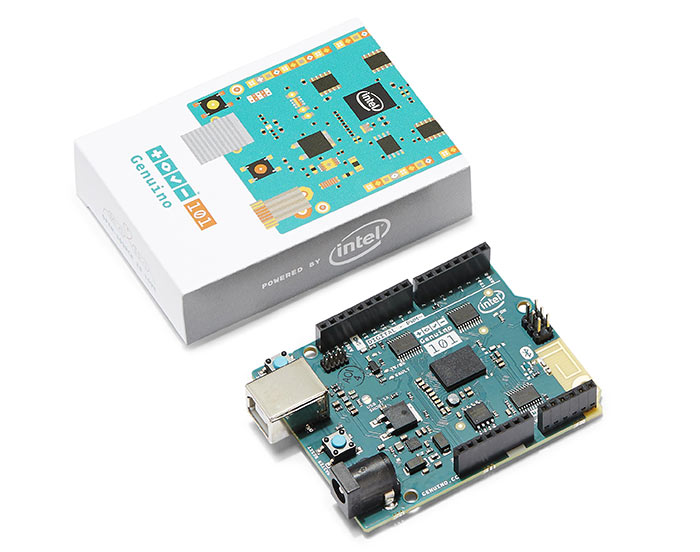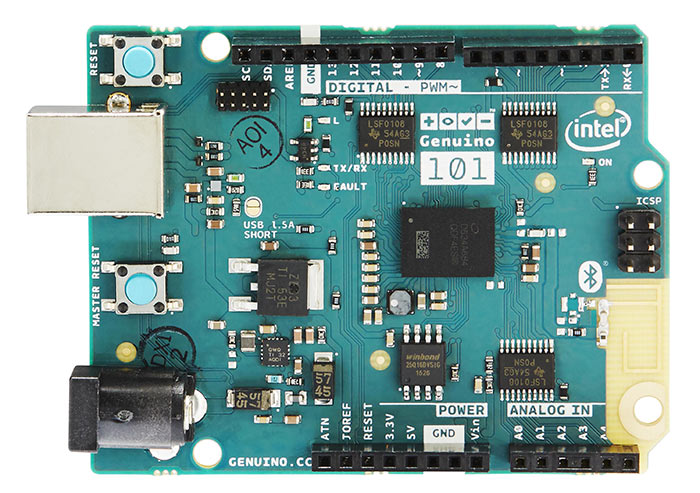Intel has launched the Genuino 101 maker board, which will be known as the Arduino 101 inside the USA. This is the first widely available development board based on the tiny, low-power Intel Curie module. The Genuino 101 is aimed at education environments, makers and embedded developers and is designed to be easy to use and affordable. It is more compact, affordable and power efficient than Intel's previous maker boards such as the Edison and Galieo.

The Intel Curie processor at the heart of the Genuino 101 has the following key features:
- A low-power, 32-bit Intel Quark SE SoC
- Up to 384kB Flash memory, 80kB SRAM
- A low-power integrated DSP sensor hub and pattern-matching technology
- Bluetooth Smart Low Energy connectivity
- 6-axis combo sensor with accelerometer and gyroscope
- Battery charging circuitry (PMIC)

The founders of Arduino have worked closely with Intel on the maker board announced today. "We worked closely with Intel on the development of this board and are expanding our educational courseware to incorporate the connectivity and advanced features expected by today's student developers," said Massimo Banzi, co-founder and CEO, Arduino. Intel will help the new maker board reach a global community of entry-level makers and students.

In the classroom Genuino 101 will be incorporated into the Creative Technologies in the Classroom (CTC) physical computing course developed and tested by Arduino and currently deployed in over 300 schools. Elementary and secondary school students will learn the foundations of programming, electronics and mechanics with the help of this hardware and the CTC course will be pushed to schools worldwide in the coming years.
For makers the new board should appeal with the combination of Arduino's open-source electronics platform and Intel's wearable-friendly processor. It is expected to be used in prototype technology-based products that 'connect and compute'. The Genuino 101 will be featured as a prototyping tool in upcoming episodes of America’s Greatest Makers on US TV.

The Intel manufactured Genuino/Arduino 101 will start to become available from Q1 2016, priced at around 27 Euros ($30, £20). There will be plenty of choice of where to buy the new device, with companies such as Amazon, Farnell Element 14, Microcenter and RadioShack all intending to carry stock of the new maker board.
|
Microcontroller |
Intel Curie |
|
Operating Voltage |
3.3V (5V tolerant I/O) |
|
Input Voltage (recommended) |
7-12V |
|
Input Voltage (limit) |
6-20V |
|
Digital I/O Pins |
14 (of which 4 provide PWM output) |
|
PWM Digital I/O Pins |
4 |
|
Analog Input Pins |
6 |
|
DC Current per I/O Pin |
4 mA |
|
Flash Memory |
196 kB |
|
SRAM |
24 kB |
|
Clock Speed |
32MHz |
|
Features |
Bluetooth LE, 6-axis accelerometer/gyro |
|
Length |
68.6 mm |
|
Width |
53.4 mm |













